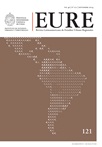Central Park y la producción del espacio público: el uso de la ciudad y la regulación del comportamiento urbano en la historia
DOI:
https://doi.org/10.4067/S0250-71612014000300003Palabras clave:
espacio público, conflicto social, historia urbana.Resumen
Los debates contemporáneos sobre el eclipse del espacio público suelen ofrecer una visión idealizada de su pasado, impidiendo una correcta reconsideración del papel que las técnicas urbanísticas han tenido en la producción y evolución del mismo. Contribuyendo al desarrollo de una historia crítica que subsane estas lagunas, Central Park se presenta aquí como un dispositivo gubernamental ideado para sustituir el régimen de uso del espacio público habitual en las calles de Manhattan a mediados del siglo XIX, por un nuevo conjunto de prácticas espaciales definidas y monitorizadas por el Estado. Tras una descripción de las formas de apropiación espontánea de la calle por parte de las clases populares, se analizan los distintos niveles proyectuales en los cuales se articulaba esta estrategia de domesticación del espacio público: del propio diseño espacial y concepción de la red de lugares del parque, a la regulación normativa del uso y comportamiento de los visitantes, al ejercicio activo de vigilancia y castigo de conductas y sujetos indeseables.
Descargas
Publicado
Cómo citar
Número
Sección
Licencia
Derechos de autor 2014 Revista EURE - Revista de Estudios Urbano Regionales

Esta obra está bajo una licencia internacional Creative Commons Atribución 4.0.
Al momento de aceptar la publicación de sus artículos, los autores deberán formalizar la cesión de derechos de autor a EURE, según las condiciones establecidas por la Revista.
Ésta establece que el autor autoriza a EURE de manera gratuita, exclusiva e ilimitada a reproducir, editar, publicar, distribuir, publicitar, comercializar y traducir el artículo, a cualquier soporte conocido o por conocer y desarrollar.
Del mismo modo, los autores aseguran que el artículo propuesto es original, no publicado y no propuesto para tal fin a otro medio de difusión.


